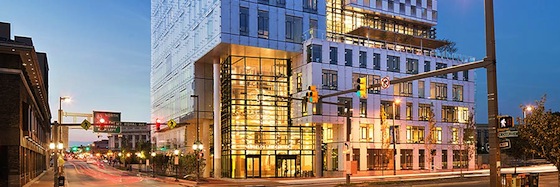As the issue of environmental preservation continues to grow in today’s culture, it is increasingly important that any new construction succeeds environmentally. With its efforts in decreasing greenhouse effects and limiting its reliance on water and energy, the new John and Frances Angelos Law Center at the University of Baltimore School of Law has done just that.
Behnisch Architekten and their partners, Ayers, Saint and Gross, designed the building so that it was faced with glass and metal panels. Three sides (except the north) actually consist of a double facade – a “rain screen.” Half-inch glass panels extend ten inches beyond the primary wall creating a double skin to assist with climate control inside the building. Additionally, the double glass also acts as a noise deflector to some extent because of the high volume intersection the building shares with popular restaurants and shops frequently visited by students.
The concrete structure itself will aid interior climate control. Built into the concrete floor slabs are more than 50 miles of plastic tubing to provide radiant heating and cooling, an ancient system famously employed in American domestic architecture by Frank Lloyd Wright. The law center does have a conventional HVAC system, but it is less than half the size of one that would be required for a typical building of its size. Sustainability was achieved through waste recycling and using recycled materials in the rebar and concrete.
Building the Law Center wasn’t the easiest task. The constructors faced multiple challenges, including the heavily trafficked area where the center is located, next door to the university’s main campus and across the street from popular bars, fast food restaurants and shops that sell school books and merchandise. However, the biggest challenge when designing The John and Frances Angelos Law Center was constructing the building on a one-acre, triangular piece of land.
As the U.S. Green Building Council reports, more than 40 percent of nonresidential buildings in the United States built this year will be green. Today’s standards on environmental preservations fall on the shoulders of architects and builders now more than ever before. With its forward-thinking design to control climate and conserve energy, the John and Frances Angelos Law Center has surpassed those standards, setting a high example for green design to come.
Source: Baltimore Brew, Architectural Record, The Baltimore Sun

